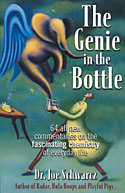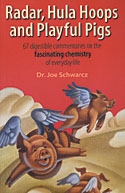Clearing the Smoke (Page 2)
Indeed, Schwarcz is a one-man media blitz, with a radio show on Montreal station CJAD; a Gazette newspaper column that runs in the Southam chain, and for a couple of years also appeared in the Washington Post; three books published by ECW Press, Radar, Hula Hoops and Playful Pigs (1999), The Genie in the Bottle (2001) and most recently, That's the Way the Cookie Crumbles, which hit bookstores in November. And, of course, he makes regular appearances on the Discovery Channel, most recently with a series on the chemistry of food entitled "Science to Go."
  Schwarcz's
books have been big sellers. His latest (next page) was released in
November. Schwarcz's
books have been big sellers. His latest (next page) was released in
November.
|
|
|
|
|
The drive to make accessible some of the more seemingly arcane points of chemistry has its genesis in his own student experience, says Schwarcz. "When I was a student, everything I studied was theory. Friends would ask me things like 'Which engine oil is better?' -- and I wouldn't know. I didn't even think of this as a 'chemistry' question." But his non-scientist acquaintances did, prompting him to find answers. Even today, he notes, "I spend a lot of time thinking about how to explain things so people will understand. Most scientists get used to their professional language and have a difficult time getting away from it. When I teach, I connect theory to practice, and people get excited by it."
Consider an example from The Genie in the Bottle, in which Schwarcz discusses the original "snake oil." Echinacea, the extract of purple coneflower, was marketed in the 1870s as "Meyer's Blood Purifier," and was claimed to be, among other things, a cure for snake bite -- hence known as snake oil. However, as it wasn't very successful at that particular application, the term came to designate a bogus medication. But echinacea did seem to work on some things -- like the common cold -- and through the 1930s was the highest selling plant medication on the market. Its popularity waned with the dawning of the age of penicillin, but has increased again as consumers have become anxious about the over-consumption of antibiotics and are generally feeling friendlier to natural therapies.
While echinacea is an "interesting substance," notes Schwarcz, the products marketed in health food stores vary wildly in their make-up and thus in their effectiveness. Much depends on the type of plant used as well as the quota of active ingredients -- and which of many ingredients might be most crucial remains uncertain. Furthermore, as no real controls exist, some bottles simply don't contain what they claim. Thus, in an article of just over 1,000 words, Schwarcz discusses the history of echinacea, its chemical make-up and consequent medical applications, and the idiosyncrasies of commercial products. The piece is an exemplar of applied chemistry, with a dose of consumer consciousness-raising for good measure.
Still, bringing chemistry to the public does have its risks. Sometimes, your audience simply isn't paying close enough attention, so that even the most conscientious of popular-media scientists can unwittingly create misconceptions. "Once on radio I talked about a dye called cochineal red, which is used in strawberry and cherry ice cream," says Schwarcz. "This dye is extracted from a small species of insect, smaller than a cockroach, that lives on cacti in the southern U.S. Then I got a letter from a lady asking me to confirm in writing so she could tell her friend that there were cockroaches in chocolate ice cream." While she heard "cockroaches" and "ice cream," the listener had missed the rest of the content. "People will get things wrong," Schwarcz sighs -- as if a story about insect juice in ice cream needed to be enhanced.
Between radio, print and television, Schwarcz is easily its most recognizable face in the English media (Fenster is more prominent among francophone audiences). However, the founding group operates very much as a team. "All the egos are checked at the door," says Harpp. And they have been for some time -- the OCS has deep roots. Back in the 1960s, when Harpp was a fresh-faced young professor, Schwarcz, a Hungarian immigrant, was one of his undergraduate students and a demonstrator in his labs. Fenster, who received his doctorate from McGill after doing his previous degrees in his native France, served on faculty with Schwarcz at Dawson College in the 1970s.
The dramatis personae in place, the story begins: one day, Schwarcz and Fenster were asked to organize a presentation for one of Dawson's Open House events. "We put together a show that used lots of slides," recalls Fenster. In addition, Schwarcz is also an accomplished magician, a talent he puts to good use in chemistry demonstrations. The performance used a recording of "The Impossible Dream" as a musical coda. "Right away, it was different from any other chemistry show," says Fenster. Soon after, in 1980, Harpp was asked to organize an exhibition on chemistry for Man and His World at the old Expo '67 site. He called upon Schwarcz and Fenster and together they developed a tremendously successful exhibition, enjoyed by 80,000 visitors. Thus was formed the triumvirate that was to become the OCS.
But a university-based attempt to get chemistry to the populace might easily have remained an impossible dream. By the mid-'80s, Schwarcz and Fenster had both moved on to Vanier College, although the three continued to do presentations together. And Schwarcz and Fenster, as adjunct professors, had co-taught with Harpp McGill's popular "World of Chemistry" course since 1981. Still, Harpp was the only one with a solid McGill base.
"I thought it would be nice to get something together collectively," he recalls. A couple of alumni dinners proved to be the necessary catalyst. On each occasion, graduates told him how much they loved the course. Harpp thought it likely that they could get some initial financial assistance "so
I called Joe and Ariel and said, 'Let's gas up the plane, take off, and refuel in mid air.'" To Harpp, the next step seemed inevitable. "Convinced by our track record, the University would find resources to hire Joe full-time."
So the process of lobbying began. As Harpp had anticipated, the idea gained support from the Department of Chemistry and the Faculty of Science, even receiving a tacit go-ahead from the Principal's office -- but no funding. Fortunately, an anonymous donor was steered toward the project by Dean of Science Alan Shaver, and in September 1999, one very substantial gift later, the Office of Chemistry and Society was born.


